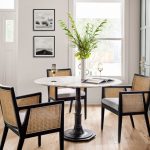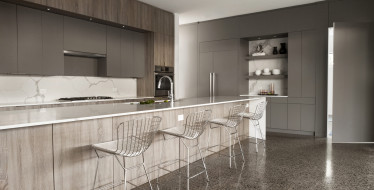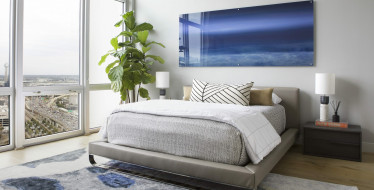Touch is a powerful sense. The perceived feel of a material or surface alone can dictate how we experience a space. Think about it – when browsing through interior design magazines or online publications, we can almost feel the plush carpet between our toes or imagine gliding our hands over the sleek marble countertop. The visual cues and millisecond experiences send signals to the brain that immediately affect how a space affects us. And that is the power of texture.
ELEMENTS OF INTERIOR DESIGN
When designing an interior space, the effects that obvious foundational elements – color, shape, pattern – have on oneself are easier to articulate. For example, in the image below, the dark colors immediately tell us this dining room is bold, edgy. At the same time, the pattern of the rug and natural tones from the wood and leather chairs soften the overall appearance.

But more is affecting how you perceive this room. It can’t be defined by color or pattern. It’s texture – another foundation to interior design. Observe the “wood” elements. The console table is sleek and reflective while the dining table has grooves like natural wood. The two pieces give a different perceived feel and style which adds to the experience of the room. This space was designed for a couple who had two different styles: modern and boho chic. With that in mind, see if you can point out how texture draws out both of our clients’ unique styles.
WHAT IS TEXTURE?
To understand how to incorporate texture in design, one must, first, be able to define it. Merriam-Webster defines texture as “the visual or tactile surface characteristics and appearance of something.” Often times, people understand texture only in the obvious form, such as velvet couches or geometric wall art. In truth, everything has texture, which means one has to decide how the textures of a space will interact with one another (or the relationship between textures in a space).

USING TEXTURE
Have you ever walked into a space and thought, “This room is heavy (or bulky),” or, “Why does this room seem flat?” That’s typically the result of overusing a certain type of texture. In general, you always want some interior design elements to pop — make a statement — while others support the space. It’s all about balance. Just like a movie or play, you can’t have a coherent story with a bunch of leading roles and no supporting characters, or vise versa. So you have know how to properly add elements to your space that will say something about you and your style.

How you decide to orchestrate texture in your space is entirely up to you and the scope of your interior design project. When remodeling or undergoing a new build, you can incorporate eye-catching texture in the elements of your space, such as 3D tiles in the wall or matte finishes on the cabinetry. If your existing space seems loud and crowded, think about removing some elements or replacing them with softer, less blaring textures. Remember, it’s all about a balanced space, and louder textures weigh more than subtler ones.
ADD TEXTURE TO YOUR MODERN SPACE
When it comes to modern design, the constant desire to have only sleek lines can oftentimes create a flat experience. In this case, adding bold textures can really liven a space. If you want to keep the colder (and we say this in the nicest way possible!), more chic look, try adding sculptural elements, such as art or wall finishes. For those who enjoy their modern spaces but love some pizzazz, one can never go wrong with adding some fluff, like a luxurious rug or throw or possibly a furry pillow or chair.

What textures you use in your interior design project will greatly determine how others experience your space and, most importantly, how you experience your space. If you feel like this is still something you need help with, we’re always here for you!
Related Posts
-
Outdoor Design Elements for Your Indoor Space
As many continue to work from home, we are spending more time indoors as there…
-
Beyond Interior Design Holiday Soiree
We officially kicked off the holiday season with our own holiday soirée! Last Saturday, we…
-
Wellness Design: Air Purification
There are many facets to wellness design. Lighting, construction materials, neutral color palettes, biophilic connectivity…








